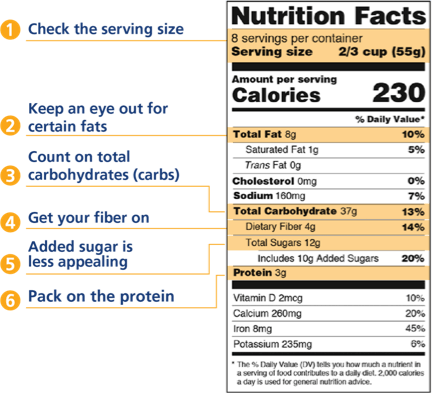
Reading food labels is a crucial skill for anyone managing diabetes. Understanding what the labels indicate can help you make informed choices that support your health and blood sugar control. In this blog, we’ll guide you through the essential components of food labels, what to look for, and what to avoid, enabling you to navigate grocery shopping with confidence.
Understanding Food Labels
Food labels provide important nutritional information about the products you consume. Familiarizing yourself with how to read these labels can help you identify foods that fit into your diabetes management plan. Here’s what you need to know.
Key Components of Food Labels
1. Serving Size
- What to Look For: Check the serving size at the top of the label, as it dictates the nutritional information that follows. Ensure the serving size aligns with how much you plan to eat.
- Tip: Compare the serving size to the amount you typically consume. If you eat double the serving size, remember to double the calories and nutrients listed.
2. Total Carbohydrates
- What to Look For: Total carbohydrates are crucial for managing blood sugar levels. This number includes sugars, starches, and fiber.
- Tip: Focus on net carbs, which can be calculated by subtracting fiber (and sometimes sugar alcohols) from total carbohydrates. Aim for meals that are lower in net carbs.
3. Sugars
- What to Look For: Look for both total sugars and added sugars on the label. Added sugars can significantly impact blood sugar levels.
- Tip: The American Heart Association recommends limiting added sugars to no more than 6 teaspoons (25 grams) for women and 9 teaspoons (38 grams) for men.
4. Fiber
- What to Look For: High-fiber foods can help stabilize blood sugar levels. Foods with 3 grams or more of fiber per serving are generally considered beneficial.
- Tip: Aim for whole foods, such as fruits, vegetables, whole grains, and legumes, which are typically higher in fiber.
5. Protein
- What to Look For: Protein can help keep you feeling full and support muscle maintenance. Look for foods with a good protein content, especially if you are managing weight.
- Tip: Include a source of protein in every meal to help balance carbohydrates and stabilize blood sugar.
6. Fats
- What to Look For: Pay attention to total fat, saturated fat, and trans fat. Choose foods low in trans fat and saturated fat to promote heart health.
- Tip: Opt for healthy fats, such as those from avocados, nuts, seeds, and olive oil.
Ingredients List
The ingredient list provides insight into what is actually in the product. Ingredients are listed in descending order by weight, meaning the first ingredient is the most prominent.
- What to Look For: Avoid products with high-fructose corn syrup, artificial sweeteners, and unhealthy fats.
- Tip: Choose foods with shorter ingredient lists that contain whole, recognizable ingredients.
Additional Nutritional Claims
Be wary of nutritional claims, as they can sometimes be misleading. Here are a few common terms to understand:
- “Sugar-Free”: May contain sugar substitutes, which can still affect blood sugar.
- “Low-Carb”: Verify the total carbohydrate count; some products may still have a significant amount.
- “Light”: Often refers to fewer calories or fat but check for other nutritional content.
Practical Tips for Grocery Shopping
- Plan Ahead: Create a grocery list based on healthy meals and snacks that fit your dietary needs.
- Shop the Perimeter: Most grocery stores have fresh produce, meats, and dairy along the perimeter, while processed foods are usually found in the middle aisles.
- Keep a Food Diary: Tracking what you eat can help you make better choices and understand how different foods affect your blood sugar.
Conclusion
Learning to read food labels effectively can empower you to make healthier food choices that support your diabetes management. By focusing on serving sizes, carbohydrates, sugars, fiber, and ingredient lists, you can navigate the grocery store with confidence. Making informed decisions will not only help control your blood sugar but also improve your overall well-being.

